Hailin Xu
Fracture interactive geodesic active contours for bone segmentation
Sep 18, 2025Abstract:For bone segmentation, the classical geodesic active contour model is usually limited by its indiscriminate feature extraction, and then struggles to handle the phenomena of edge obstruction, edge leakage and bone fracture. Thus, we propose a fracture interactive geodesic active contour algorithm tailored for bone segmentation, which can better capture bone features and perform robustly to the presence of bone fractures and soft tissues. Inspired by orthopedic knowledge, we construct a novel edge-detector function that combines the intensity and gradient norm, which guides the contour towards bone edges without being obstructed by other soft tissues and therefore reduces mis-segmentation. Furthermore, distance information, where fracture prompts can be embedded, is introduced into the contour evolution as an adaptive step size to stabilize the evolution and help the contour stop at bone edges and fractures. This embedding provides a way to interact with bone fractures and improves the accuracy in the fracture regions. Experiments in pelvic and ankle segmentation demonstrate the effectiveness on addressing the aforementioned problems and show an accurate, stable and consistent performance, indicating a broader application in other bone anatomies. Our algorithm also provides insights into combining the domain knowledge and deep neural networks.
A novel algorithm for optimizing bundle adjustment in image sequence alignment
Nov 10, 2024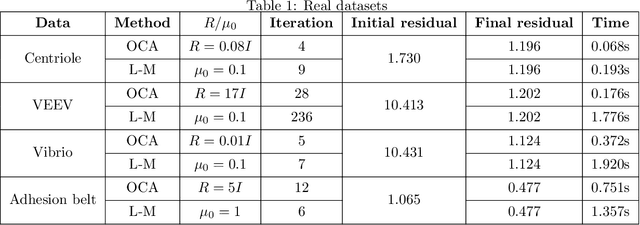
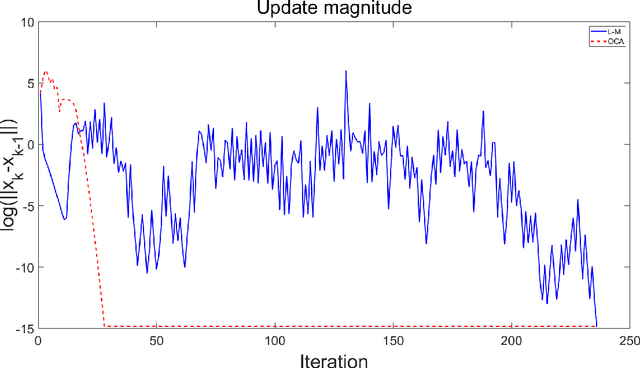
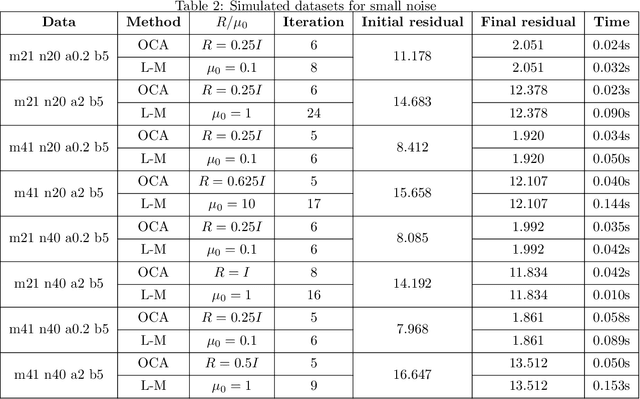
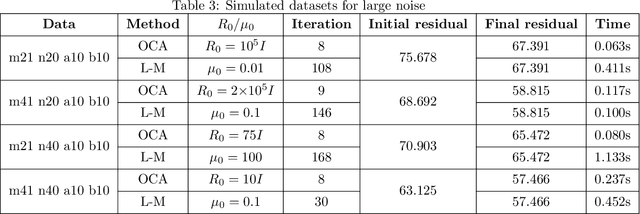
Abstract:The Bundle Adjustment (BA) model is commonly optimized using a nonlinear least squares method, with the Levenberg-Marquardt (L-M) algorithm being a typical choice. However, despite the L-M algorithm's effectiveness, its sensitivity to initial conditions often results in slower convergence when applied to poorly conditioned datasets, motivating the exploration of alternative optimization strategies. This paper introduces a novel algorithm for optimizing the BA model in the context of image sequence alignment for cryo-electron tomography, utilizing optimal control theory to directly optimize general nonlinear functions. The proposed Optimal Control Algorithm (OCA) exhibits superior convergence rates and effectively mitigates the oscillatory behavior frequently observed in L-M algorithm. Extensive experiments on both synthetic and real-world datasets were conducted to evaluate the algorithm's performance. The results demonstrate that the OCA achieves faster convergence compared to the L-M algorithm. Moreover, the incorporation of a bisection-based update procedure significantly enhances the OCA's performance, particularly in poorly initialized datasets. These findings indicate that the OCA can substantially improve the efficiency of 3D reconstructions in cryo-electron tomography.
A multi-stage semi-supervised learning for ankle fracture classification on CT images
Mar 29, 2024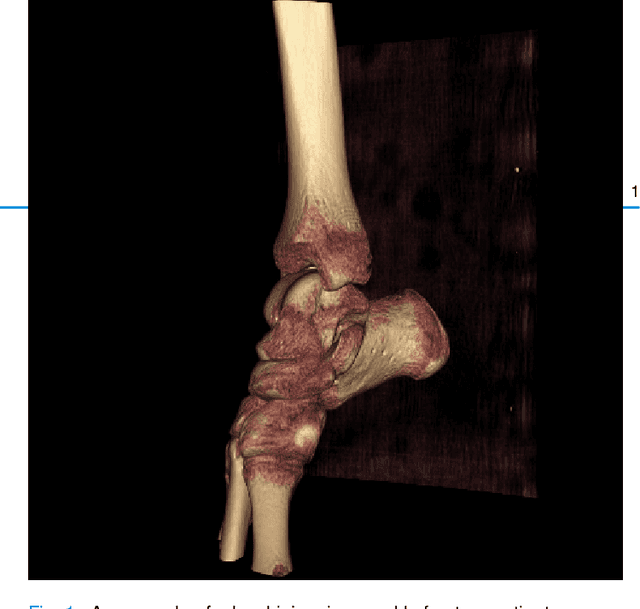
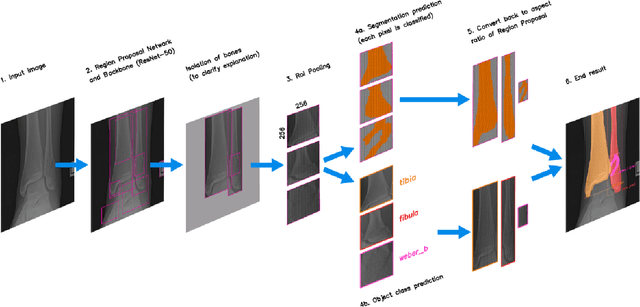
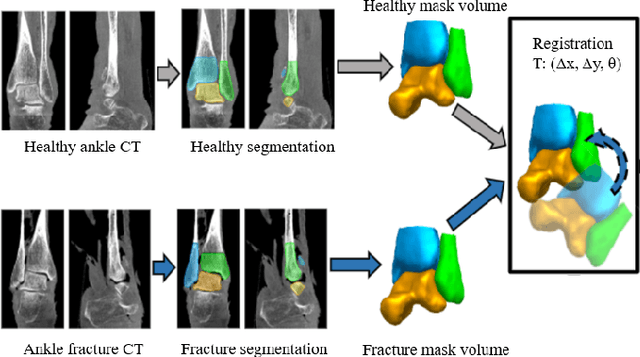
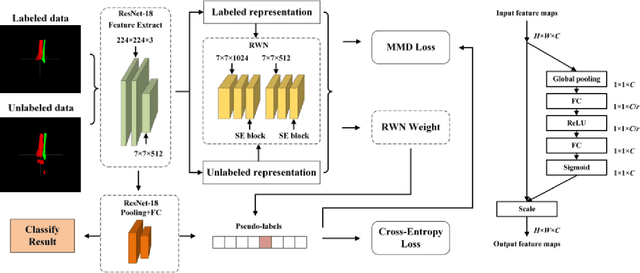
Abstract:Because of the complicated mechanism of ankle injury, it is very difficult to diagnose ankle fracture in clinic. In order to simplify the process of fracture diagnosis, an automatic diagnosis model of ankle fracture was proposed. Firstly, a tibia-fibula segmentation network is proposed for the joint tibiofibular region of the ankle joint, and the corresponding segmentation dataset is established on the basis of fracture data. Secondly, the image registration method is used to register the bone segmentation mask with the normal bone mask. Finally, a semi-supervised classifier is constructed to make full use of a large number of unlabeled data to classify ankle fractures. Experiments show that the proposed method can segment fractures with fracture lines accurately and has better performance than the general method. At the same time, this method is superior to classification network in several indexes.
Calcaneus Radiograph Analysis System: Rotation-Invariant Landmark Detection, Calcaneal Angle Measurement and Fracture Identification
Feb 05, 2020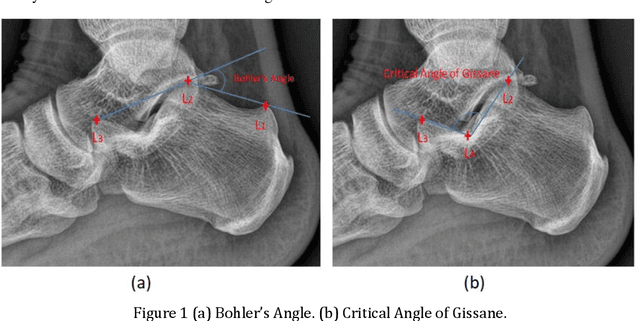

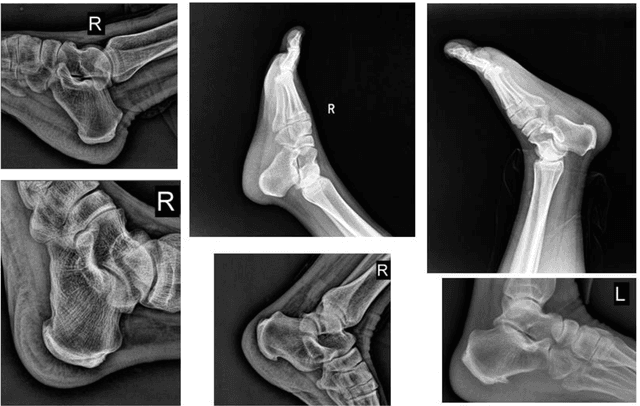

Abstract:Calcaneus is the largest tarsal bone to withstand the daily stresses of weight bearing. The calcaneal fracture is the most common type in the tarsal bone fractures. After a fracture is suspected, plain radiographs should be taken first. Bohler's Angle (BA) and Critical Angle of Gissane (CAG), measured by four anatomic landmarks in lateral foot radiograph, can aid operative restoration of the fractured calcaneus and fracture diagnosis and assessment. The aim of this study is to develop a system to automatically locate four anatomic landmarks and measure BA and CAG for fracture assessment. To solved the problem of fickle rotation of calcaneus, we proposed a coarse-to-fine Rotation-Invariant Regression-Voting (RIRV) landmark detection method based on Supported Vector Regression (SVR) and Scale Invariant Feature Transform (SIFT) patch descriptor. By implementing a novel normalization approach to convert displacements into coordinates of oriented feature patches, our method is explicit rotation-invariance comparing with traditional regressive method. A multi-stream CNN structure with multi-region input is designed to screen calcaneus fracture. The input ROIs of multi-stream CNN are normalized by detected landmarks to uniform view, orientation and scale. The advantage of our approach is the usage of landmarks using prior knowledge to normalize the inputs of CNN so as to improve the efficiency of CNN. Experiments show that our CNN can accurately identify the fractures with sensitivity of 95.21% and specificity of 95.32%.
 Add to Chrome
Add to Chrome Add to Firefox
Add to Firefox Add to Edge
Add to Edge